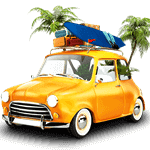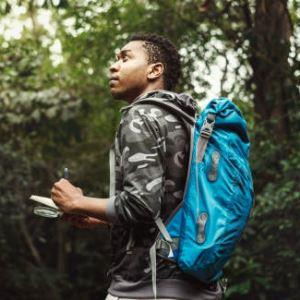 Travelling around Kenya as a UK tourist is both exciting and manageable with the right planning. Kenya offers a variety of transport modes that cater to different needs, preferences and budgets. From bustling cities to serene wildlife reserves, each destination calls for a tailored travel solution. Understanding your options is key to a smooth and enriching experience. For long-distance travel, domestic flights are a top choice. Airlines like Jambojet and Safarilink operate regular flights from Nairobi to cities such as Mombasa, Kisumu, and Eldoret. These flights are fast, affordable, and ideal for covering large distances within hours. Booking in advance ensures seat availability and better fares, especially during the peak safari season. For more scenic or road-based experiences, private safari vehicles are highly recommended. Many UK tourists prefer this mode for national parks and game reserves. These 4x4s come with experienced drivers, are comfortable, and are best suited for wildlife excursions. If you’re seeking something flexible, car hire services with drivers are available with assistance from reputable companies. These offer door-to-door convenience, especially for family groups or those who prefer structured itineraries. Urban transport in Nairobi and Mombasa includes matatus and city buses. Matatus are colourful minibuses that run set routes; while they offer a genuine local experience, it’s essential to use regulated services under licensed saccos. City buses like Citi Hoppa offer more formal transit for new visitors. Ride-hailing apps such as Bolt and Uber are widely used and trusted. For intercity travel, modern coaches like Modern Coast and Easy Coach provide reliable services connecting key cities. Choose daytime trips for safety and comfort, and reserve your seat in advance. These buses are especially popular among budget-conscious travellers. Planning your routes from the UK involves mapping out your itinerary around Kenya’s main tourist areas: Nairobi, the coast, the Rift Valley, and the national parks. Use Google Maps for distance estimates, and consult with local operators to align your transport with accommodation and activities. Our professionals assist in coordinating seamless travel plans that reduce stress and maximise adventure. By combining air, road, and local transport, UK tourists can experience Kenya’s rich landscapes, culture, and wildlife safely and efficiently. With a calm approach to planning and reliable local support, getting around Kenya becomes an enjoyable part of the journey itself.
Travelling around Kenya as a UK tourist is both exciting and manageable with the right planning. Kenya offers a variety of transport modes that cater to different needs, preferences and budgets. From bustling cities to serene wildlife reserves, each destination calls for a tailored travel solution. Understanding your options is key to a smooth and enriching experience. For long-distance travel, domestic flights are a top choice. Airlines like Jambojet and Safarilink operate regular flights from Nairobi to cities such as Mombasa, Kisumu, and Eldoret. These flights are fast, affordable, and ideal for covering large distances within hours. Booking in advance ensures seat availability and better fares, especially during the peak safari season. For more scenic or road-based experiences, private safari vehicles are highly recommended. Many UK tourists prefer this mode for national parks and game reserves. These 4x4s come with experienced drivers, are comfortable, and are best suited for wildlife excursions. If you’re seeking something flexible, car hire services with drivers are available with assistance from reputable companies. These offer door-to-door convenience, especially for family groups or those who prefer structured itineraries. Urban transport in Nairobi and Mombasa includes matatus and city buses. Matatus are colourful minibuses that run set routes; while they offer a genuine local experience, it’s essential to use regulated services under licensed saccos. City buses like Citi Hoppa offer more formal transit for new visitors. Ride-hailing apps such as Bolt and Uber are widely used and trusted. For intercity travel, modern coaches like Modern Coast and Easy Coach provide reliable services connecting key cities. Choose daytime trips for safety and comfort, and reserve your seat in advance. These buses are especially popular among budget-conscious travellers. Planning your routes from the UK involves mapping out your itinerary around Kenya’s main tourist areas: Nairobi, the coast, the Rift Valley, and the national parks. Use Google Maps for distance estimates, and consult with local operators to align your transport with accommodation and activities. Our professionals assist in coordinating seamless travel plans that reduce stress and maximise adventure. By combining air, road, and local transport, UK tourists can experience Kenya’s rich landscapes, culture, and wildlife safely and efficiently. With a calm approach to planning and reliable local support, getting around Kenya becomes an enjoyable part of the journey itself.
Transport Modes for UK Tourists in Kenya
| Transport Mode | Cost Estimate (Daily) | Best For | Key Benefits | Cautionary Notes |
|---|---|---|---|---|
| Private Safari Vehicle | £100–£200 | Safari parks, countryside | Comfort, guided experience | Costly, book early |
| Domestic Flights | £30–£90 (per leg) | Long distances | Time-saving, comfortable | Luggage limits |
| Matatus | £1–£3 | City and peri-urban travel | Inexpensive, fast | Can be chaotic, pick licensed saccos |
| City Buses (Nairobi) | £0.50–£1 | Nairobi city centre | Affordable, regulated | Limited to city zones |
| Intercity Buses | £10–£20 | Town-to-town travel | Reliable, frequent service | Avoid night travel |
| Rental Car + Driver | £60–£150 | Group travel, personalized tours | Flexible routes, safe navigation | Fuel not always included |
Best Ways for UK Tourists to Get Around Kenya
Choosing how to get around Kenya is one of the most important decisions for UK tourists planning an unforgettable trip. Each transport option provides a different lens through which to explore the country’s diverse landscapes, cultures and wildlife. Whether you're chasing sunsets over the savannah or navigating the vibrant streets of Nairobi, selecting the right mode of transport shapes your entire experience. Below are some of the most effective and enjoyable travel methods to consider:
- Private Safari Vehicles: Ideal for those seeking exclusive and immersive safari experiences, private safari vehicles are commonly used in game parks like the Maasai Mara, Amboseli, and Tsavo. These vehicles are typically 4x4s fitted with pop-up roofs, offering great visibility for photography and wildlife viewing. A professional driver-guide often accompanies the journey, sharing valuable insight into the ecosystems and animal behaviours. This option offers unmatched comfort and safety, especially on rugged or remote routes.
- Domestic Flights: Covering long distances quickly, domestic flights are popular for connecting Nairobi with regional destinations like Mombasa, Diani, Kisumu and various airstrips within national parks. Airlines like Safarilink, Jambojet, and AirKenya offer regular schedules and are known for their safety standards. These flights save time and reduce the fatigue of long road journeys, especially valuable for tourists with limited travel days.
- Chauffeured Car Services: A great middle ground between guided tours and independent travel, chauffeured car services offer flexibility without the stress of navigating unfamiliar roads. This option is ideal for city transfers, custom day trips, and intercity travel. Licensed operators provide vetted, knowledgeable drivers who ensure punctuality and security. It’s also an excellent solution for families, business travellers, or those arriving from the UK who may be jet-lagged or unaccustomed to local traffic rules.
These travel methods offer distinct advantages depending on the nature of your trip, budget, and comfort level. Whether by air, road, or a personalised driver service, getting around Kenya can be smooth and memorable when well-planned.
Public Transport Options in Kenya for Foreign Visitors
Public transport in Kenya is vibrant and essential, especially for UK tourists seeking to experience the country like a local. Though sometimes perceived as chaotic, Kenya’s public transport system connects urban centres, rural towns, and key tourist attractions efficiently and affordably. Understanding how to navigate these services safely can greatly enhance a visitor’s travel experience. The most visible form of public transport in Kenya is the matatu. These privately-owned minibuses operate on fixed routes and are widely used in cities like Nairobi and Mombasa. Matatus are known for their vibrant art, loud music, and bustling pace. While adventurous tourists may be drawn to their cultural authenticity, first-time visitors should use matatus operated by regulated saccos (savings and credit cooperative organizations). These provide relatively safer and more predictable services. City buses offer a more structured alternative. In Nairobi, the green Citi Hoppa and yellow City Shuttle buses serve major roads and business districts. These buses follow scheduled routes and are regulated, making them more suitable for visitors less familiar with local transit norms. Fares are low and usually paid in cash, though some operators have introduced mobile payment options. Ride-hailing apps such as Bolt, Uber, and Little Cab are transforming urban transport in Kenya. They provide a user-friendly, secure, and cashless option for getting around cities. Tourists can order a ride using a smartphone, track the driver’s location, and pay with international cards. These services are particularly useful for airport transfers, hotel commutes, or short city trips. For intercity travel, long-distance buses are a reliable option. Companies like Modern Coast, Easy Coach, and Guardian Angel operate routes linking Nairobi with Mombasa, Kisumu, Eldoret, and other towns. These buses offer multiple travel classes, including economy, business, and VIP. To ensure safety and comfort, it’s best to book tickets in advance and travel during daylight hours. The Nairobi Commuter Rail is another public option, connecting suburbs like Ruiru and Syokimau to the city centre. Though mainly used by daily commuters, it offers an insightful look into daily Kenyan life and avoids the notorious Nairobi traffic. Public transport can enrich your trip to Kenya with authentic experiences and local interactions. While safety and convenience should always guide your choices, using public transit offers insight into Kenyan society and a deeper connection with the country. When complemented with occasional private transfers or guided tours, it provides a balanced, memorable travel experience.
How to Use Matatus Safely as a UK Tourist
Matatus are a colourful, fast-paced part of Kenyan life and a popular mode of public transport. For many UK tourists, using a matatu is a fascinating cultural experience that offers an authentic view of how locals move around. However, safety and awareness are critical to make the most of this unique opportunity. Understanding the system helps visitors navigate it with confidence. Matatus are privately owned minibuses that operate fixed routes in cities and towns across Kenya. They are known for their loud music, vibrant artwork, and quick stops. While they can appear chaotic to first-time users, they are an essential, affordable mode of transport for many Kenyans. As a tourist, your safest bet is to use matatus operated by registered saccos (Savings and Credit Cooperative Organizations). These operators are subject to certain regulatory standards and often provide a more orderly and secure service. The first step to using matatus safely is choosing the right one. Look for names like Super Metro, Embassava, or City Hoppa. These companies are well-known, have established routes, and tend to uphold higher safety standards. It is wise to avoid matatus that appear overcrowded or poorly maintained. If in doubt, seek advice from your hotel concierge or a local guide. Timing your travel is also key. Try to avoid peak hours typically between 7 AM to 9 AM and 5 PM to 7 PM when matatus are often overcrowded. Mid-morning and early afternoon are ideal times to travel, as the vehicles are less packed and the pace is more manageable. Always aim to travel during daylight hours, especially if you are unfamiliar with your destination. Once on board, secure your personal belongings. Carry bags across your body and keep zippers closed. Avoid using your phone or displaying valuables openly, as petty theft can occur in busy settings. If seats are available, take one rather than standing, as the ride can be bumpy and sudden stops are common. If you’re unsure of where to alight, communicate clearly with the conductor, known locally as the "makanga." They assist with fare collection and route information. Have small change ready for your fare and confirm the cost before boarding if possible. Most city routes charge between 30 and 100 Kenyan Shillings, depending on distance and time of day. With some planning, awareness, and the right attitude, using matatus can be an enjoyable and insightful way for UK tourists to explore Kenya's cities and suburbs.
Tips for Hiring a Car in Kenya as a UK Visitor
Hiring a car in Kenya is an excellent way for UK tourists to explore the country with flexibility and freedom. Whether planning a self-drive holiday or preferring the ease of a vehicle with a driver, this option opens access to scenic landscapes, hidden gems, and lesser-known towns. Kenya’s road network has improved significantly over the years, especially in major cities and on intercity highways. However, navigating these roads requires some understanding of local conditions and legal requirements.
- Choose a Reputable Rental Company: Stick with international or well-reviewed local car hire companies. These agencies maintain vehicles properly and provide valid insurance and roadside assistance.
- Ensure You Have the Right Documents: UK tourists must carry a valid UK driving license and an International Driving Permit (IDP). Most agencies will also request a passport, visa, and a credit card for the security deposit.
- Select the Right Vehicle Type: For city driving, compact cars are sufficient. If you’re heading to rural areas or parks, opt for a 4x4. Kenya’s national parks and some off-the-beaten-track destinations require vehicles with high ground clearance and rugged suspension.
- Consider Hiring a Driver: Driving in Kenya can be challenging due to unfamiliar traffic rules, uneven roads, and unpredictable driving habits. Hiring a vehicle with a driver helps reduce stress and improves safety. Drivers also offer local knowledge, helping you navigate better and discover local spots.
- Check Insurance Coverage: Comprehensive insurance is a must. Make sure the coverage includes theft, third-party liability, and off-road use if required. Read the fine print to avoid hidden costs.
- Avoid Night Driving: Night driving is strongly discouraged, especially outside major towns. Roads can be poorly lit, and there is an increased risk of encountering animals, pedestrians, or stalled vehicles.
- Map Your Route Ahead of Time: Use Google Maps or offline apps like Maps.me to plan your journey. Cell service may be limited in remote areas, so download maps in advance and ensure your vehicle has a spare tire, jack, and first-aid kit.
With the right planning and preparation, hiring a car in Kenya offers UK visitors a rewarding, flexible way to explore the country's vast beauty at their own pace.
Is It Safe to Travel by Bus Across Kenya?
Travelling by bus across Kenya can be a safe and enriching experience for UK tourists when approached with informed planning. Kenya’s bus network is extensive and connects most major towns and cities, making it a popular option for both locals and international visitors seeking an affordable and practical mode of transport. However, like any form of public travel, it requires careful consideration of safety practices and travel conditions. Several reputable bus companies operate intercity services, including Modern Coast, Easy Coach, and Guardian Angel. These companies have established reputations for safety and reliability, and they offer a range of service levels from basic economy to luxury VIP classes. Most of these buses come equipped with comfortable seats, seatbelts, and onboard amenities such as air conditioning and Wi-Fi. Booking tickets in advance is highly recommended, particularly for long-distance routes and during peak travel periods. Daytime travel is generally the safest choice when using buses in Kenya. Roads are more navigable in daylight, and bus stations and rest stops are more secure during active hours. Night travel, though common and often cheaper, is discouraged due to increased risks from road hazards, fatigue-related accidents, and occasional incidents of highway crime. If night travel is unavoidable, choose premium services with good safety records and avoid isolated or informal bus stops. Bus terminals in major cities like Nairobi, Mombasa, and Kisumu are usually well-organised, but tourists should remain vigilant. Keep valuables close, avoid engaging with aggressive touts, and use officially designated ticket counters. Always verify bus schedules and the boarding point in advance to avoid last-minute confusion. For personal security, always sit near the front of the bus, where you’re in clearer view of the driver and less susceptible to pickpocketing. Keep important documents and money in a secure pouch or travel wallet. Some buses offer onboard attendants feel free to seek assistance if needed. It’s also wise to familiarise yourself with your route beforehand using digital maps or consulting your accommodation host. Many long-distance buses make scheduled stops, and it helps to know when and where to disembark. Buses in Kenya offer an accessible and scenic way to explore the country’s diverse regions. While the experience may differ from UK public transport standards, UK tourists who choose reputable operators, plan their trips carefully, and prioritise daytime travel will find bus journeys across Kenya both safe and rewarding.
How to Plan Your Transport Routes in Kenya from the UK
 Planning your transport routes in Kenya from the UK allows for a smoother and more confident travel experience once you arrive. With Kenya’s diverse geography from the urban bustle of Nairobi to the tranquil savannahs of the Maasai Mara understanding how to move between these areas is vital. The key to successful travel planning lies in outlining your desired destinations and aligning them with the most suitable transport modes available in Kenya. Start by identifying your entry point, which for most UK visitors will be Jomo Kenyatta International Airport in Nairobi. From here, you can build your route around Kenya’s major travel circuits: the coast (Mombasa, Diani), the Rift Valley (Naivasha, Nakuru), western Kenya (Kisumu), and safari regions (Masai Mara, Amboseli, Tsavo). Using digital tools like Google Maps or Rome2Rio helps visualise these regions and estimate travel times between destinations. For long distances, domestic flights are highly recommended. They offer significant time savings and are reliable if booked in advance. Flights from Nairobi to Mombasa, Kisumu, or Amboseli take less than an hour and are offered by trusted carriers like Safarilink, Jambojet, and AirKenya. These services are especially useful when trying to cover large areas on a tight schedule. If your journey involves more remote or rural destinations, consider hiring a car with a driver. This option gives you maximum flexibility and allows you to travel at your own pace. It also removes the stress of navigating unfamiliar road conditions and traffic rules. We help UK travellers plan bespoke itineraries, including vehicle arrangements and professional drivers familiar with local routes. Public transport options like long-distance buses or matatus may also be part of your route if you’re open to authentic, cost-effective experiences. However, these modes should be used with caution and preferably during daylight. Booking through reputable operators and verifying schedules online can help you avoid unexpected detours or delays. Coordinate your transport with your accommodations to streamline your schedule. Many hotels and lodges offer airport or terminal transfers. Confirm these options when booking and ask if they can recommend reliable local taxi or shuttle services for nearby attractions. Always allow buffer time between connections, especially if you’re transitioning between different transport modes. Kenyan roads can be unpredictable, and weather or traffic may affect travel times. With good planning, UK visitors can enjoy safe, seamless movement throughout Kenya, enhancing every step of their journey.
Planning your transport routes in Kenya from the UK allows for a smoother and more confident travel experience once you arrive. With Kenya’s diverse geography from the urban bustle of Nairobi to the tranquil savannahs of the Maasai Mara understanding how to move between these areas is vital. The key to successful travel planning lies in outlining your desired destinations and aligning them with the most suitable transport modes available in Kenya. Start by identifying your entry point, which for most UK visitors will be Jomo Kenyatta International Airport in Nairobi. From here, you can build your route around Kenya’s major travel circuits: the coast (Mombasa, Diani), the Rift Valley (Naivasha, Nakuru), western Kenya (Kisumu), and safari regions (Masai Mara, Amboseli, Tsavo). Using digital tools like Google Maps or Rome2Rio helps visualise these regions and estimate travel times between destinations. For long distances, domestic flights are highly recommended. They offer significant time savings and are reliable if booked in advance. Flights from Nairobi to Mombasa, Kisumu, or Amboseli take less than an hour and are offered by trusted carriers like Safarilink, Jambojet, and AirKenya. These services are especially useful when trying to cover large areas on a tight schedule. If your journey involves more remote or rural destinations, consider hiring a car with a driver. This option gives you maximum flexibility and allows you to travel at your own pace. It also removes the stress of navigating unfamiliar road conditions and traffic rules. We help UK travellers plan bespoke itineraries, including vehicle arrangements and professional drivers familiar with local routes. Public transport options like long-distance buses or matatus may also be part of your route if you’re open to authentic, cost-effective experiences. However, these modes should be used with caution and preferably during daylight. Booking through reputable operators and verifying schedules online can help you avoid unexpected detours or delays. Coordinate your transport with your accommodations to streamline your schedule. Many hotels and lodges offer airport or terminal transfers. Confirm these options when booking and ask if they can recommend reliable local taxi or shuttle services for nearby attractions. Always allow buffer time between connections, especially if you’re transitioning between different transport modes. Kenyan roads can be unpredictable, and weather or traffic may affect travel times. With good planning, UK visitors can enjoy safe, seamless movement throughout Kenya, enhancing every step of their journey.
Frequently Asked Questions for UK Tourists on Transport in Kenya
Navigating transport in Kenya can feel daunting for UK tourists, especially on a first visit. With a little foresight and the right information, getting around this vibrant country becomes a smooth and exciting part of your adventure. Below are some of the most common voice-search-optimized questions UK tourists ask when planning how to travel in Kenya:
- Can UK tourists use Uber in Kenya? Yes. Uber is available in Nairobi, Mombasa, and Kisumu. It's a safe, affordable, and efficient option for local travel. You can pay using international cards linked to your Uber account or in cash. Other apps like Bolt and Little Cab also offer similar services with broad coverage.
- Do UK visitors need an international driving permit in Kenya? Yes. In addition to a valid UK driving licence, you must carry an International Driving Permit (IDP) to legally drive in Kenya. This is mandatory for car hire and is often requested at police checks.
- Is it safe to take buses for long-distance travel in Kenya? Yes, provided you use reputable bus companies like Modern Coast, Guardian Angel, or Easy Coach. Travel during the day is safest, and it’s best to book tickets in advance and avoid remote bus stops or late-night travel.
- What is the cheapest way for UK tourists to travel around Nairobi? Matatus are the most affordable option, costing less than £1 for short distances. However, for safety and convenience, many tourists prefer using ride-hailing apps or regulated city buses like Citi Hoppa.
- Are domestic flights in Kenya reliable for tourists? Yes. Domestic airlines such as Safarilink, Jambojet, and AirKenya offer frequent and timely flights between cities and safari destinations. They are generally punctual and safe, especially when booked early.
- How can I get from Nairobi to Mombasa as a UK tourist? You can take a domestic flight, which takes about one hour. Alternatively, the Madaraka Express train is a comfortable six-hour ride offering scenic views and air-conditioned coaches.
- Is it safe to travel alone as a UK tourist in Kenya? Yes, with some precautions. Use licensed transport, avoid night travel, and stay connected with local operators or your accommodation. Pre-booked private transfers or guided tours are best for solo travellers.
- Can I pre-book transport in Kenya from the UK? Absolutely. Many local travel operators offer online booking for transfers, domestic flights, car rentals, and guided tours. Pre-booking helps ensure availability and better coordination upon arrival.






